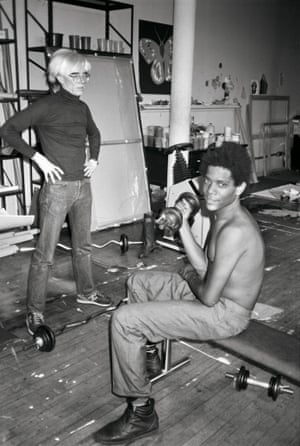 |
| Jean-Michel Basquiat and Andy Warhol outside the Mary Boone Gallery, New York, 3 May 1984. Photograph: The Andy Warhol Foundation |
Andy Warhol's friendship with Jean-Michel Basquiat revealed in 400 unseen photos
Book offers ‘voyeuristic glimpse’ into the two artists’ lives with hundreds of Warhol’s images and diary entries
Dalya Alberge
Monday 20 May 2019
A“voyeuristic” glimpse into the world of two of the late 20th century’s greatest artists is to be revealed in a book that finally brings to light some of the 130,000 photographs that Andy Warholtook to document every aspect of his life.
More than 32 years after Warhol’s death, hundreds of his photographs are set to reveal the minutiae of his friendship with fellow artist Jean-Michel Basquiat, capturing many moments together – whether partying, getting their nails painted, or even, for Basquiat, while in the depths of depression facing suicidal thoughts.
Andy Warhol was a pioneer in many ways, with his ideas about pop art, celebrity culture and creativity as a business. But perhaps one area he is less recognised as being ahead of his time is his tendency to photograph his every moment.
 |
| Jean Michel at Yanna’s nail salon, August 29, 1983, by Andy Warhol. Photograph: The Andy Warhol Foundation |
Now, 32 years after the artist’s death, hundreds of his photographs, which reveal the minutiae of his friendship with fellow artist Jean-Michel Basquiatbetter than any modern social media feed, are to be published for the first time in a new book.
Theirs was a complex relationship, which began in 1980s New York. Warhol – with his depictions of movie stars, soup cans and Brillo-pad boxes – was already one of the world’s most famous artists, and Basquiat was a rising star from the graffiti scene. Warhol’s unexpected death in 1987 took its toll on Basquiat, who was found dead from a heroin overdose the following year, aged 27.In a forthcoming book, Michael Dayton Hermann of the Andy Warhol Foundation in New York has matched entries from Warhol’s published diaries with more than 400 of his photographs, most of which have not been published before.
He describes it as “a voyeuristic glimpse” into the artists’ lives. Warhol captured his private life through the lens of his 35mm camera, but printed only a small fraction of the 130,000 negatives.Hermann told the Guardian: “What is shocking and striking is the honesty of the photographs. Today, with social media we all share our lives online, but we do so in a very managed way, to project an image ... the photographs are brutally honest. When you read Warhol’s text, he can be catty and gossipy. The photos are very similar.”
He singled out a diary entry of 1983, in which Warhol wrote: “Jean-Michel came by and said he was depressed and was going to kill himself and I laughed and said it was just because he hadn’t slept for four days.”
Hermann said that Warhol actually photographed that moment, depicting Basquiat looking utterly downcast in a soulless hotel room: “Wow, we truly are a fly on the wall during this very intense moment.”
Asked whether Basquiat would have been aware that he was being photographed, he said: “Absolutely. People were annoyed by Warhol at times because he was always photographing. People theorised that he used the camera as a social crutch of sorts, by removing himself behind a camera.”
Warhol was clearly obsessed with the minutiae of Basquiat’s life. Nothing was too banal. He showed him shaving – even taking a closeup of his wash basin – getting dressed, lying on a bed, and trying on clothes in a boutique’s changing-room. There are images of Basquiat exercising and intimate depictions where he is wearing only a jockstrap.
Basquiat dropped out of school, and left home aged 17, living on the streets and in abandoned buildings, before finding recognition for his graffiti-like images and scrawled texts. In 1982, he was introduced to Warhol, who recalled in his diary: “He’s the kid who used the name ‘Samo’ when he used to sit on the sidewalk in Greenwich Village and paint T-shirts, and I’d give him $10.”
Their friendship blossomed, and they began collaborating on art. Through his camera, Warhol watched Basquiat at work.Some images depict the two artists, taken with Warhol’s camera, larking around pretending to box or partying.
In 2014, the foundation gave its entire holdings of Warhol negatives to Stanford University, California, which has scanned everything to make the collection available to the public.
For his forthcoming book, Hermann decided to focus on Basquiat “to better understand what this relationship was really about”.
He said that, while Warhol and Basquiat’s artistic collaboration has long reflected a relationship they shared between 1982 and 1987, the photographs paint another picture. Noting that there is no evidence that they were lovers, he added that their friendship defies easy description: “it was deeply caring and emotionally complex.”
Hermann said: “They were very inspired by each other. Warhol early on really understood that Basquiat was a terrific artist.”
Few modern artists can compete with the extraordinary prices that the pair command today. In 2017, Basquiat’s untitled depiction of a skull sold for$110.5m, exceeding the $105m record for an American artist at auction set byWarhol’s Silver Car Crash (Double Disaster) in 2013.
Hermann’s book Warhol on Basquiat will be published by Taschen next month.



No comments:
Post a Comment